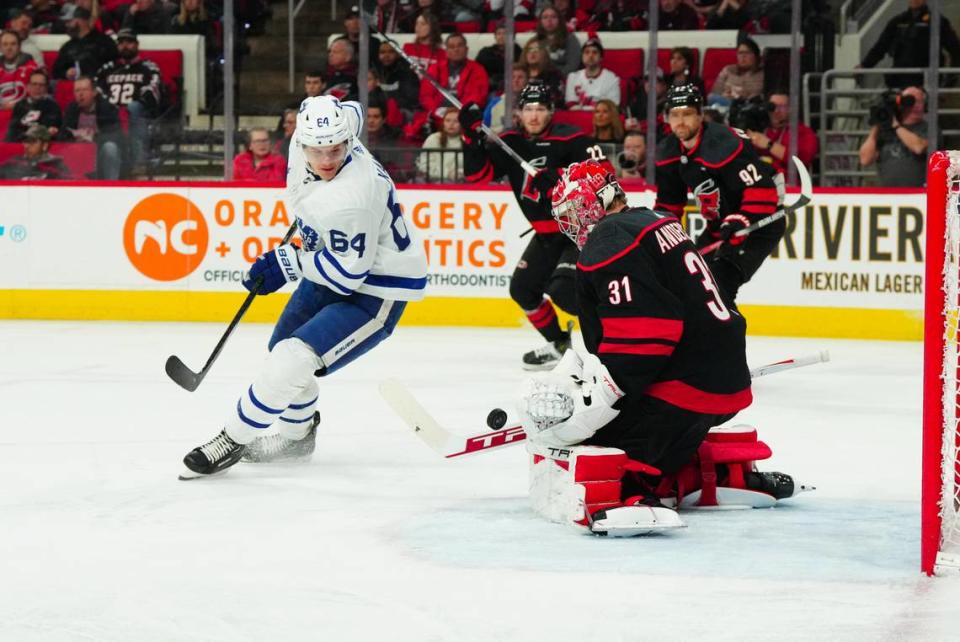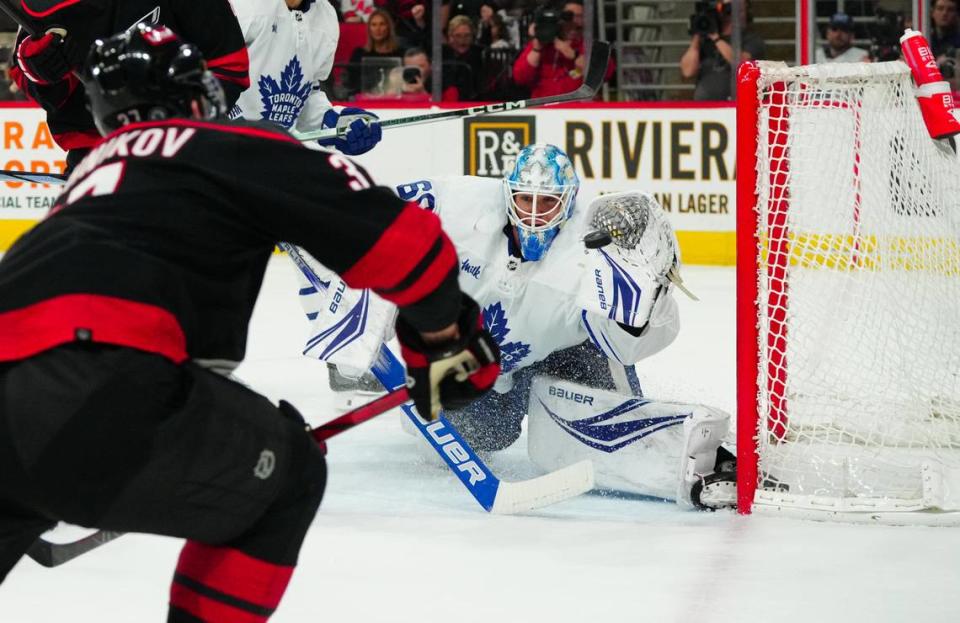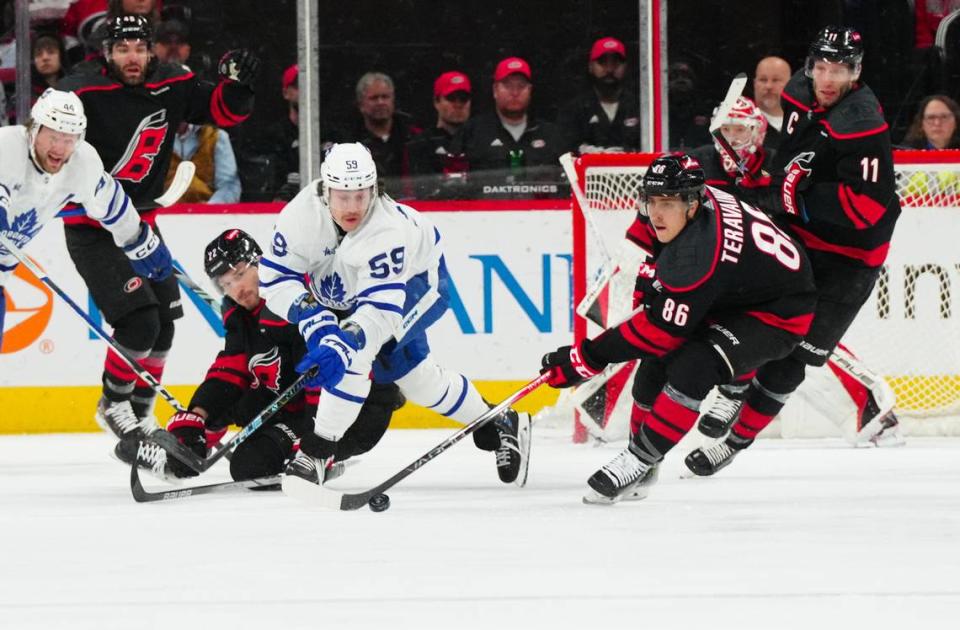Why depth is on the Carolina Hurricanes’ side as the NHL enters the stretch run
- Oops!Something went wrong.Please try again later.
- Oops!Something went wrong.Please try again later.
- Oops!Something went wrong.Please try again later.
- Oops!Something went wrong.Please try again later.
- Oops!Something went wrong.Please try again later.
The NHL doesn’t afford its teams a spring break — unless you count the end-of-season sojourn half the league’s teams will take when the playoffs start in April — choosing instead to give every team a bye week around the league’s winter All-Star Game.
That can make for some brutal stretches throughout the rest of the season, especially as teams with playoff and division title aspirations jostle for position in March.
The madness is not reserved for the hardwood this time of year.
The Hurricanes are smack in the middle of their busiest stretch of the 2023-24 season. The Canes have not had two consecutive days off since March 7, and won’t until after their game on March 30, a stretch of 14 games in 24 days that includes three consecutive calendar weeks with four games.
Sunday’s game against the Toronto Maple Leafs at PNC Arena marked the end of a particularly tough stretch of six games in nine days for the Canes, who were also coming off an uncharacteristic, high-scoring shootout loss in Washington.
But instead of the Hurricanes looking fatigued, it was quite the opposite, at least through the first half of the game.
Brady Skjei’s 12th goal of the season just 1:06 into the game — on the Canes’ second shot — set the tone against a Toronto team that skated at home Saturday against Edmonton. Sebastian Aho added another later in the first and that was all the offense Carolina and goalie Frederik Andersen needed in a 2-1 win over the Maple Leafs.
Andersen won his 10th game of the season — in 12 starts — to help the Hurricanes extend their point streak to seven games. The Canes are 9-1-1 in their past 10 games as they chase down the New York Rangers in the Metropolitan Division.
Depth charge
Depth becomes that much more important when the schedule gets constricted — not only straight roster depth with the ability to substitute tired or injured players, but scoring depth.
Sunday’s game offered a glaring juxtaposition in roster construction. The Maple Leafs have been at or near the top of the Atlantic Division standings for years, but famously unable to take the final steps toward achieving the ultimate goal of winning a Stanley Cup. The Canes, of course, have gone from also-ran to feel-good resurrection story to perennial contender in the past 10 years, and are hoping their latest roster moves will be the key to achieving what the Leafs have been unable to.
The Leafs’ roster boasts three of the top-20 point scoring forwards in the NHL — Auston Matthews, William Nylander and Mitch Marner. Nylander and Matthews are 7-8 in points, with Marner at No. 20. Matthews’ 58 goals are far and away the best in the league.
But the Leafs also pay for it — literally. They have nearly $30 million tied up this season in those three players alone. Add in John Tavares for $11 million more, and that’s a shade under half of the team’s full salary cap on four players. Two of them — Matthews and Nylander — are contracted to get raises next season.
Those four players also account for 316 of the team’s 672 points this season, 47% of the Maple Leafs’ total.
The Hurricanes have … one person in the top 20 in NHL scoring — Aho, who with his hat trick against Washington on Friday and his goal Sunday reached 31 goals and 80 points for the season. But the Canes also don’t pay Aho — or anyone on the roster — as much as the Maple Leafs pay each of their “big four,” choosing instead to spread the team’s cap wealth across the roster. That’s led to the team having 10 players with more than 30 points this season, six with 40 or more. Toronto has only seven above 30.
When the Hurricanes had to sit a few players a week ago with minor injuries — Teuvo Teravainen, Jack Drury and Jesper Fast missing time — they didn’t miss a beat, despite the hectic schedule. With the additions of Jake Guentzel and Evgeny Kuznetsov at the trade deadline, an injury of significance to one of the top 10 scoring skaters on the Canes’ roster, while still detrimental, would be easier to absorb.
In Toronto, it could be — and has been — more disruptive. Sunday, Marner missed another game — his seventh recovering from a high ankle sprain suffered March 7.
Andersen solid ... again
In his sixth start — his fifth at home — after missing more than 40 games while dealing with a blood-clotting issue, Andersen again showed what he’s capable of when he’s healthy.
In 12 games this season, now equal numbers on either side of his long layoff, Andersen is 10-1 with a goals-against average under 2.15 and a save percentage of .924.
Andersen moved well in the opening period Sunday, stopping everything that came his way in a relatively uneventful frame.
The opening minutes of the second were more dramatic. Andersen twice played the puck into Toronto players on his own, resulting in a pair of great scoring opportunities for the Leafs. With a pair of acrobatic saves, Andersen redeemed himself and kept his former team off the board.
Later in the period, Andersen made a snappy glove save on a late Leafs power play, and another as the second-period horn sounded to preserve the Canes’ two-goal cushion.
Andersen then stared down a 2-on-0 five minutes into the third period, and turned that aside as well, sending PNC Arena into a familiar chorus of “Fred-die, Fred-die!”
In the third, after allowing a goal, Andersen shut the door amid the Leafs’ last-minute flurry with the goalie pulled to earn the win.
They had the power
Strength met strength Sunday, with the Hurricanes and Maple Leafs power plays sporting equally impressive season success rates.
Prior to Sunday’s game, the Hurricanes had the third-best power play in the NHL, with the team’s units scoring at a 26.4 percent clip. Toronto, with its aforementioned high-powered top forwards zipping around with extra space on the ice, was fourth in the NHL at 26.1 percent.
The difference is striking, though, on the other side of the special teams coin. Carolina is second in the NHL with an 86.1 percent kill rate while shorthanded. The Maple Leafs are 26th at 76.2 percent. The discrepancy is even more staggering when you consider the Canes have been shorthanded on average 3.21 times per game, seventh highest in the NHL, spending 5:18 per game down a skater. Toronto is near the bottom of the league with just 2.80 times shorthanded per game.
In Sunday’s game, the Hurricanes’ second goal came on the power play, an Aho bank shot off a Toronto defender. The Canes’ penalty kill held the Maple Leafs scoreless on four attempts. In three games this season, Toronto is 0 for 10 on the power play against Carolina.





